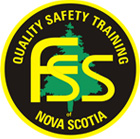Storage of Flammable Materials
Hazards Identified
Fire, explosion
Hazard-Specific Personal Protective Equipment
Safety glasses
Hazard-Specific Training
Training or orientation by a competent person
Safe Work Practice
- Where flammable materials are stored, a fire extinguisher must be present on site.
Flammable Liquids (such as toluene and varsol):
- Read the MSDS for each flammable liquid in use and follow instructions for storage.
- Store bulk flammable materials in their original containers, outdoors if possible, or in a properly labelled and well ventilated area which is isolated from all sources of ignition.
- Transfer only the amount of flammable liquid needed to day use containers. Use only properly labelled CSA or UL approved containers.
- Use a CSA or UL approved flammable storage cabinet for indoor storage of small amounts. Ensure that the flammable storage cabinet is properly installed, including venting to the outside.
Non-Refillable Propane Cylinders:
- Non-refillable propane cylinders (such as the 12, 16 or 30 ounce sizes used for soldering) may be stored indoors. Keep quantities to a minimum.
Refillable Propane Cylinders:
- Always transport and store cylinders in an upright position unless they are designed for horizontal use, such as cylinders designed for fuelling forklift trucks.
- Cylinder valves must be turned off and regulators must be removed prior to transport.
- When transporting or storing cylinders, a proper plug must be put in the valve to keep it clean.
Storage of Flammable Materials (continued)
- The protective collars provided on cylinders are not to be used for mechanical lifting. Proper cradles or platforms for holding cylinders are to be used. Crane hooks must be equipped with a safety latch.
- Cylinders which are not in use must be stored outdoors or in a well ventilated shed which has no sources of ignition, and no electrical service or electrical fittings which are explosion proof.
- Use light colored paint on the cylinder to keep the temperature from rising if it will be stored indirect sunlight.
- Cylinder storage area must be properly labelled.
Regulations, Standards and References
Occupational Safety General Regulations;
Compressed Gas Association standard CGA P-1-191, “Safe Handling of Compressed Gases in Containers”;
Fire Prevention Act and Regulations;
